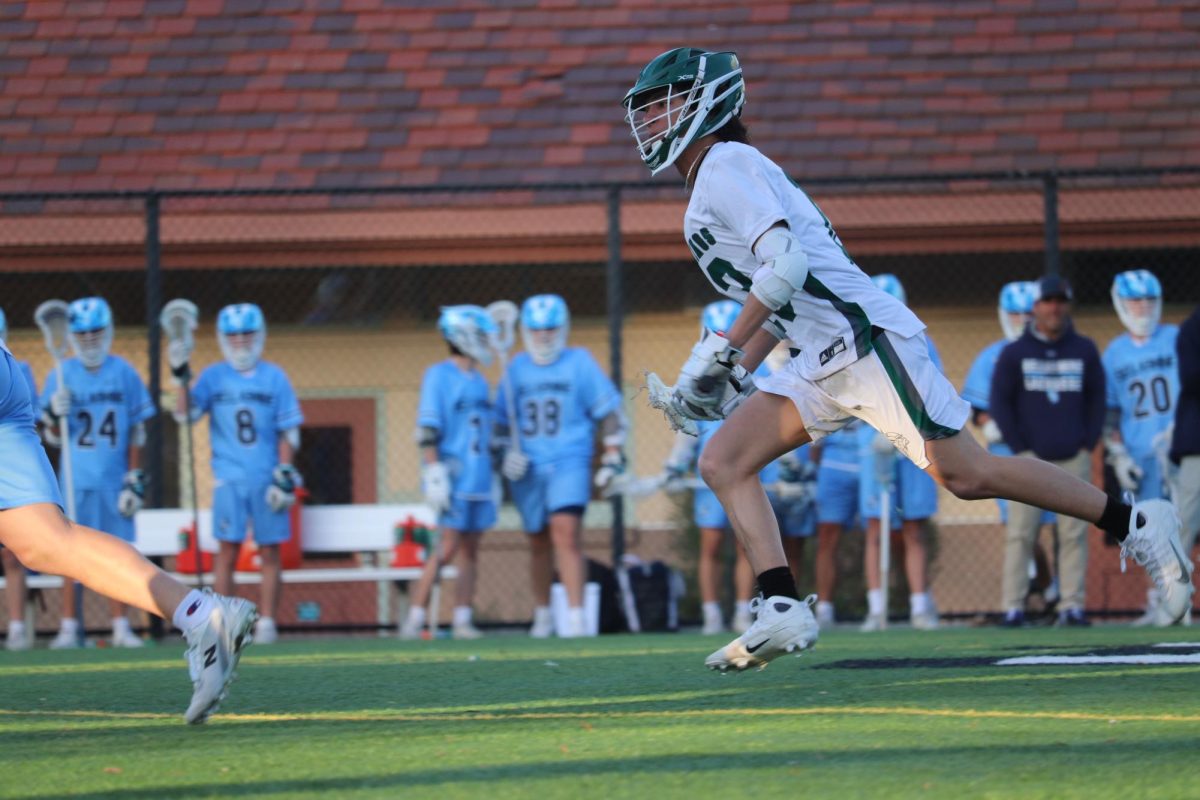Cat Fight
December 3, 2018
The buzz of floodlights is barely audible over the screams of the crowd. The stadium is filled with voices clamoring for attention, raspy from having chanted during all of spirit week but desperate to make this night the loudest all year. Despite the noise, the players on the field are as locked-in as ever. Their faces are shielded by their helmets, expressions indiscernible, but their body language says it all: today, the game is about more than just football.
Yes, it’s the homecoming game, but this Friday night is about more than defending our ground. Tonight is a rematch against Los Gatos, the last of which resulted in another loss for Paly on what should have been a celebration of senior pride and school spirit. Gatos dancing away with homecoming victories has become almost a tradition, one the football team is hungry to put an end to.
Tonight, the result will be a hard-fought 35-10 victory for Paly. But go back 14 years – or even eight, or four – and the Wildcats had the Vikings’ number.
The Gatos rivalry is widely recognized amongst Palo Alto students, but it is peculiar. Most people have heard the chants of FLG floating through bleachers, the rumors of heated disputes ending in violence or tears, or have experienced the animosity in person as athletes or fans, but the majority of students rooting against Gatos don’t even know why they’re supposed to hate the team.
The origins of the rivalry aren’t clear, but a good place to start is Gunn’s decline. Paly’s old cross-town rival began to fade down the rankings, eventually making its way to a different league in virtually every sport. It was no longer as enjoyable to play against a team that provided less competition, and that’s when Paly’s attention turned to Los Gatos. Similarly, Gatos’ archrival Saratoga worsened over time, turning the Wildcats’ attention towards the Vikings.
“I really don’t think [the Gunn rivalry] went away, I think we just never play them in sports anymore because they aren’t in our league for most sports,” Esme Stotland (‘19) said.
However, the rivalry wouldn’t have been nearly as intense had Gatos not provided stiff competition. The Los Gatos sports program has always been an exceptional one; they’ve often been the standard to beat in the Santa Clara Valley Athletic League. Their dominance is most well known in football, of course, but it extends to lacrosse, water polo, basketball, and almost everything in between.
“It’s a good competitive rivalry,” former athletic director and physical education teacher Jason Fung said. “It’s great competition, and that’s why everyone gets geared up for it. You want to beat Los Gatos.”
The competition in football was a particular sore spot for a number of years. From 2014 to 2018, the Wildcats beat the Vikings four consecutive times. Even before in 2009, they’d beaten Paly eight out of 10 times. At that point if you could even call it a rivalry, it was certainly entirely one-sided.
In the world of basketball, the Los Gatos rivalry has blossomed within the last few years. League games have always been competitive, but in 2017 when both the girls and boys varsity teams faced off against the Wildcats in the Central Coast Section (CCS) finals, the high stakes and growing tension from the back-to-back games intensified the already present kerfuffle.
“For basketball it was always an exciting game, since we saw each other in CCS and in league, but I wouldn’t call it a rivalry because we always got the best of them in the playoffs,” Paly graduate Will Schlemmer (‘18) said.
The girls teams played first, followed by the boys. The first game was intense as both the Vikings and the Wildcats left their blood, sweat and tears out on the court. The score fluctuated throughout the first half, but the Lady Vikes were able to pull through and ended up winning the game by a score of 52-41. The boys game brought competition to a whole new level. The entire game was back and forth, so much so that the game was tied down to the last second. Every person in the stands was at the edge of their seats not knowing what to expect. Just as doubt began to creep into the minds of some, Paly hit a three point buzzer beater, winning them the second CCS division I title of the night. From that moment on, the rivalry between Palo Alto and Los gatos only grew larger.
“We see each other as the biggest threat to each others dominance,” Paly graduate Nathan Willis (‘18) said.
Beyond both schools having competitive athletic departments, the schools are so similar in terms of community wealth and demographics that comparisons between the two are inevitable. When one school seems to be falling short in one category, comparisons to the “superior” school can abound, and either break the spirit of the lesser team or inspire a competitive fierceness to prove the doubters wrong.
“The girls have an understanding that this game is everything,” basketball player Grace Thayer (‘20) said. “You leave everything you have on the court.”
Demographics aside, Gatos games are simply ones that draw the biggest crowds. Just like the affectionately nicknamed “Holy War” games between St. Francis and Bellarmine, not only do Gatos-Paly games have the highest stakes until playoffs, they are games that many members of the Paly community look forward to due to the the long history of dramatic finishes, and an equal amount of tradition as high-level competition. Athletes and fans alike know to mark the date of Los Gatos matches on their calendar – the crowds are the most raucous, the players feel they have something to prove, and the environment becomes electric.
“Going to the football games that we play against Los Gatos is really exciting,” Faisal
Ojjeh (‘20) said. “From start to beginning it’s very intense. It’s just great going out there especially when we’re up so I can cheer on our team against one of our bigger rivals.”
Varsity swimmer Tom Galetti (‘20) added that the rivalry is natural, and stems from the talent both teams have.
“Obviously when the two best teams in the league go at it, no, you’re not gonna love the other team,” Galetti said. “Do I hate Gatos? No. Do I not like them? Yes. But I have a ton of respect for them too.”
So while the development of the rivalry developed slowly, with dislike growing steadily over the years, once it was there it made its presence known with a bang. Suddenly, the rivalry was transforming from an unspoken entity lurking under the surface to a full-blown, physical hatred. And that hatred, suddenly tangible and real, manifested itself physically too.
An altercation at a 2016 girls lacrosse game ignited a spark of animosity between the two sides that carried the rivalry off the playing field and into something personal, with barbs exchanged – where else – on the realm of social media. At the game, a member of the Los Gatos boys lacrosse team heckled and tormented a member of the Paly girls team from the stands. The level of hostility and malice involved caused the member of the Paly girls team to break down in tears. This encounter led to a full scale social media battle, with many Paly students targeting the specific heckler on the Los Gatos boy lacrosse team. There is no doubt that this encounter not only heightened the animosity between the two sides but also gave the rivalry a face for Paly students to target.
The role of social media played a critical part in escalating the tension. In traditional face-to-face rivalries jeering between fans and players alike, as well as close controversial games, keep the mutual dislike afloat. However with the rise of the online world, cruel words are taken from the stadium to the screen, making them all the more impossible to escape. With traditional trash talk, the animosity is reserved to the game, and good sportsmanship and respect returns as soon as the buzzer sounds. But the ever-connected media sphere means the game never ends.
“Social media has definitely made it easier for people to trash talk,” David Hernandez (‘19) said. “Especially because of how you’re anonymous and feel safer knowing you can’t be confronted.”
Despite the physicality the rivalry sometimes finds itself turning to, and riffs between players, most of the life that is breathed into the rivalry comes from the “Sixth Man”: the fans. The most notorious manifestation is the FLG chants – something that both administrations take issue with.
“The FLG [chant] is completely out of line,” Paly administrator and assistant principal Jerry Berkson said.
Before the first game of the CCS playoffs for football versus Los Gatos, principal Adam Paulson took to Schoology to remind – read: warn – students that the unsportsmanlike behavior would not be tolerated: “I am asking students to please show good sportsmanship in the stands, especially when it comes to our group cheers. Let’s keep them focused on our team and always positive. During our homecoming game, I heard some cheers that were not in good taste and not representative of who we are as a school. Let’s have fun and show our opponents that we are gracious hosts and represent our school and team with pride and class.”
The administration is very much aware of the heated tension between the two teams. So aware, in fact, that Palo Alto and Los Gatos administrators have begun meeting to discuss logistics for reducing the likelihood of player confrontations.
“There are healthy and unhealthy rivalries,” Berkson said. “Currently, we have an unhealthy rivalry. It’s pretty classless.”
Unsportsmanlike conduct at the homecoming game this year ended up being the straw that broke the camel’s back. Conversations had happened before last year, according to Berkson, but the tension between the schools had become dangerously high since then.
“It’s a crazy atmosphere,” Berkson said. “Two really good teams vying for a championship [is] ripe for this rivalry to grow.”
The solution for now? More authoritative presence at games.
“We said [at the meeting] administrators will be at every Los Gatos-Paly event, and it was definitely necessary to have a conversation because we could be playing them in CCS in the next few weeks.” Berkson said.
And the ultimate goal of the logistical discussion is simply to limit the opportunities for confrontation. This has, after all, been one of the main roots of physical conflicts.
“There would be less interaction between fans of both sides,” Berkson said. “We will, at some point, have a joint Paly-Los Gatos student meeting with athletes and ASB that’s gonna come up.”
But of course, being at Paly, the only perspective the student body has on the rivalry is internal. We hear stories from our friends, essentially urban legends by the time they reach our ears. They have been convoluted and exaggerated so much they are hardly recognizable. We decide we hate this opposing school, and that they must lose at all costs – they’re collectively violent, rude, and a waste of our energy.
These are all gross oversimplifications, and oftentimes plainly false. Paly most certainly isn’t absolved of all blame in the numerous conflicts that have transpired between the two schools, and Gatos isn’t the purely evil faceless entity we’ve often made them out to be. Just like us, they’re a high school that’s desperate to win, and the few individuals that take the conflict too far shouldn’t represent the entire student body.
Ultimately, rivalries wane and grow depending on the strength of the opposition. No one school can be entirely at fault, or entirely innocent in the matter. But from the bitter inferiority Paly possessed decades ago against Gatos, to the Vikings’ apparent dominance as they enter the CCS playoffs hoping to find glory once again, the development of the feud between the two schools certainly isn’t over. As for where it goes next? Check back in after the playoffs – either way, you’re guaranteed a good time.












